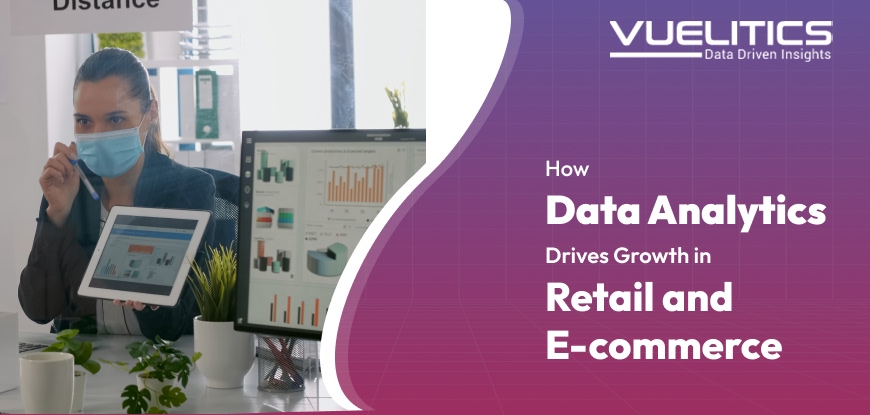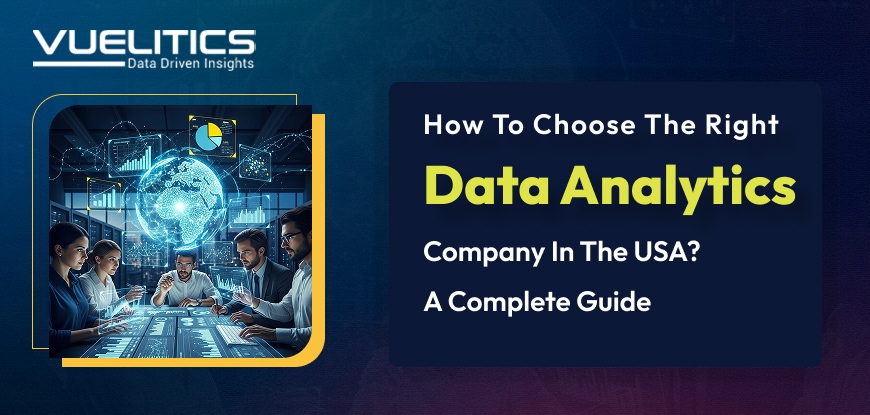- Home
- Blogs

How Data Analytics Drives Growth In Retail And E-commerce?
Data analytics is a crucial defining element for retailers and e-commerce in the hyper competitive digital era. Every e-commerce business needs untethered access to data to remain competitive. Turning that raw data into business insights can allow retailers to make more intelligent decisions. It improve customer experiences, and streamline operations. Here, we are going to discuss the use of data analytics in the retail and e-commerce sector, which is changing the industry and responsible for eco-friendly business expansion.
How Data Analytics Is Revolutionizing the Retail and E-Commerce Sector?
An Insight into Data Analytics in Retail and E-commerce
Retail analytics and e-commerce analytics depend on the integration of different data sources regarding the point of sale (POS) transactions, customer interactions, social media usage, and inventory management to support logical decision-making. Such insights enable brands to glean what their customer base desires, how they act and how they can improve the purchase journey at every turn.
Retail has traditionally been in-store focused, but omnichannel analytics combines offline and online data to give a full 360-degree view of how the business is performing. This integrated model allows customers to engage effortlessly, online and in person.
Data-Driven Retail Expansion to Drive Growth: From Insights to Strategy
Companies that are data-driven in their approach to expanding retail operations outperform competitors. With the right tools and models, companies can forecast demand, improve pricing strategies, and personalize marketing—resulting in higher profitability and customer loyalty.
Retailers leverage business intelligence for retail to identify trends, measure KPIs, and make data-backed decisions. This improves efficiency and reduces guesswork so leaders can stay nimble in a fast-changing market.
Understanding Customer Behavior through Analytics
Understanding consumer buying patterns, preferences and desires is key to customer behavior analysis.
The use of click streams, product views and shopping cart data analysis makes it possible for retailers to segment audiences and develop personalized campaigns.
As an example, a fashion E-commerce business can utilize analytics to monitor returning customers, understand their favorite style, and suggest the products that they may be interested in.
This strategy is helping drive higher engagement, conversion and overall customer experiences.
Personalization: The Secret to Retaining Your Customers
The Contemporary Consumers are expecting highly relevant experiences. With retailing predictive analytics, companies can look at historical and behavioral data to determine what customers are likely to buy next.
This level of personalization goes beyond product recommendations, it affects dynamic pricing, personalized email marketing and loyalty programs. Personalized shopping experiences enhance trust, recommendation and repeat purchase rates for brands through one brand shop.
Inventory Optimization Using Data
For retailers, one of the biggest problems is managing inventory. Data-driven inventory optimization makes sure the right products are there at the right time, but not too many or too few so you don’t run out.
Real-time retail intelligence enables businesses to monitor the movements of stock from warehouses to stores. Moreover, analytics software is able to monitor product demand trends, thus enabling more efficient procurement and supply chain planning. This then lowers the charges for storage and improves their cash flow.
Retail Sales Forecasting and Predictive Analytics
Knowing exactly how much product to order and where is a major challenge as we are faced with supply chain disruptions, lack of space for stock, and workforce allocation issues, so being able to forecast sales accurately for retail provides the strong foundation needed. The predictive analytics in retail allow businesses to predict when they will experience peaks and troughs in sales throughout the year, so they can prepare for them.
Machine learning models, which crunch sales records, weather patterns and consumer sentiment to predict demand more accurately, are seeing increasing use. These predictions allow managers to be proactive rather than reactive.
Data-Driven Marketing Campaigns
Outdated marketing is being replaced with an analytics-focused approach to marketing, no longer relying on “best-guess” approaches. Marketers can create ultra-targeted promotions by studying customer demographics, engagement metrics and purchase histories.
For instance, an e-commerce website can display re-targeting ads with cart abandonment data or send such discounts to inactive users. These customized campaigns drive CTR and conversion while making the most out of ROI.
Enhancing Customer Retention Strategies
Adhering to the guiding motto that it’s easier (and more profitable) to make money off of people you already have, there are many reasons for wanting to keep current customers on board. Analytics-driven strategies now prevent churn by identifying those customers at risk before they leave.
Retailers are now able to watch for customer happiness, measure engagement and allow loyalty programs thanks to e-commerce analytics. And automatic alerts enable marketers to also send custom messages when a customer purchases less frequently, helping the brand maintain a rapport with its customers.
Omnichannel Analytics: Bridging the Online-Offline Divide
Shoppers today hop across multiple platforms—mobile, desktop and physical stores—before they buy. Omnichannel analytics unifies data from all these sources to provide consistent customer experiences.
Businesses can also connect online advertising to in-store visits or see how in-store activity influences customers’ purchases online. This multichannel strategy makes it so that no customer touch point is left behind.
Retail Intelligence to help Make Decisions Faster
Real-time retail intelligence allows companies to adapt on the fly to market shifts. Whether recalibrating pricing strategies or reacting to a sudden spike in demand, real-time analytics enables teams to act immediately on data.
Retailers might, for example, track social media trends or sudden spikes in product interest to change promotions on the fly and take advantage of every possible sale opportunity at key times.
The Role of BI in Retail Expansion
Retail business intelligence is not just reporting—it can drive strategic change. With BI solutions, the decision-makers can have a bird’s-eye view of sales trends, supply-chain efficiency and marketing effectiveness via easy-to-consume dashboards.
Enabling BI and data analytics for business growth derives a culture of continuous improvement. More specifically, they can find areas of inefficiency, forecast trends and make data-driven investments that drive long-term success.
Conclusion
From how customers behave to how best to operate, data analytics in retail and data analytics in e-commerce are revamping the way businesses grow. Whether you’re looking to boost customer loyalty, improve stock management, or provide personalized shopping experiences—data puts retailers a step ahead of the competition.
With the advancement of technology, retailers that do leverage data-driven retail growth. Will unlock new opportunities for innovation, efficiency and customer satisfaction—establishing themselves as leaders in an era of commerce that’s yet to be seen.
FAQ: Data Analytics & Its Impact On Retail & E-Commerce
What is retail and e-commerce data analytics?
This is the gathering of sales, customer and inventory data that is taken and made into meaningful information for better decision-making, increased sales and a superior buying experience.
How does big data analytics contribute to retail growth?
The platform provides retailers with everything they need to better understand their customers’ behavior, predict demand, leverage inventory and run data-driven marketing campaigns to help grow their business.
What is retail and predictive analytics?
Predictive analytics relies on prior and present data to predict sales, customer tastes, and demand for products.
How does an analysis help with customer retention?
Retailers can also use this to match buying behavior with the level of engagement. So they offer tailored promotions and loyalty programs to help go head-to-head against Walmart.



Post Comments